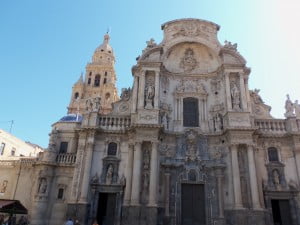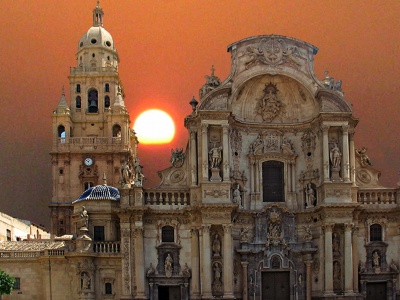
Murcia City.
First, the city of Murcia is situated in the province of Andalusia.
In the past , Andalusia is a region with great influence of the Muslims.
So, Murcia was founded by the Moors during the 9 st century.
While, the influence of the Islamic culture has lasted over more than 500 years. And can still be seen today.
Since the foundation of Murcia, the town has been a crossing for several civilizations.
The location on the river, Rio Segura, is important for Murcia.
Furthermore, the coast of the region of Murcia is also known as the” Costa Calida”. It means the warm coast.
The best is that Murcia is one of the most typical towns in this Spanish region. Together with Cartagena it is a typical Spanish city.
Further, Murcia is the capital of the Murcia region.
Visitors certainly will enjoy your time in Murcia. The Moors have influenced the architecture within the old town.
The old town is very beautiful with churches, museums, narrow streets and many cozy plazas.
Tourist information
It is located in the heart of the city, opposite to the Cathedral.
The place is one of the most important meeting points for tourist and locals. One of the reason, the plaza is full of restaurants and bars.
Guided tours in English.
The tourism department of Murcia offers a series of guided tours in English. And this around some of the region most interesting places.
For example there will be a tour in April of Torre Pacheco. So participants will visit this municipality and the famous windmill an it museum.
Visitors will have the possibility to participate in the town of Torre Pacheco to the annual windmill fiesta . So visitors can lean more about the heritage of the town and its culture.
In May there is a guided tour of “ Alahama de Murcia” . This tour focus on the most important points of the city. The tour visit the places in the urban center. To sum up : San Lazaro church, Plaza Vieja, El Positon, Tercia house, Los Martires garden, the town hall of the city and the archaeology museum.
The meeting point is the tourist information office.
Another very interesting tour is the tour called ” Life in the world of Salt ” . This tour takes you to the San Pedro regional park in San Pedro del Pinitar. The tours take you to the park that crosses the salt lakes. Count to make a walk for 4 kilometers and about 2 hours . So wear comfortable footwear and clothes.
You are in Spain, so bring a sunscreen , a hat and water with you. Do not forget your binoculars to observe the wild life at the Salt lakes.
More information about this tour in June at the Tourist office.
The further the tourist information offers a ” boat trip”. Indeed the next tour is a boat crossing of the Mar Menor in June.
University.
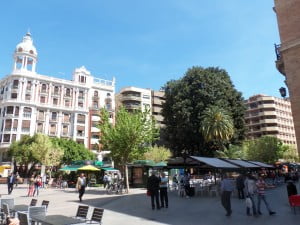
The City is a university town. It is a witness of a splendid authentic rich Spanish classical heritage . You can explore it at the “ caso antiguo “ or the old city.
From here, explore the plazas and the little narrow streets.
In those streets, you will find interesting art gallery’s, nice shops, and small museums.
The town has an array of beautiful historic buildings and museums.
Before starting a visit to the museums, tourist visit the local tourist information. In the office you can find more information about maps, dates and opening hours.
Because the opening hours can change depending on the winter or the summer season .
Do not forget the Siesta time. The time to relax.
Some museums offers free guided visits, so it is best to get informed.
The shopping Malls.
So, Murcia has one of the largest shopping areas. It is out-of-town but is consist of two large malls and also Ikea. Everyone likes the Ikea, the locals and the expats. Because is just the same as in their own country. See shopping in Murcia
The Nueva Condimima shopping center is set over two floors.
The Thader shopping center also has two floors.
Parking is free for the two shopping malls. So keep it calm and take your time to shop.
The football stadium of Real Murcia.
Is popular by the male tourist .
Terra Nature of Murcia.
Terra Nature is an animal park nearby Murcia. it ha s a twin brother in Benidorm. More about this zoo at Benidorm? Read our page .
The park that has over 50 species of trees and plants and more than 320 animals.

This zoo is 166 000 square meters is split into two zones.
In particular , the African Savannah and the Iberian Peninsula.
In brief, Terra Natura is a new generation Zoo . This is a new concept in habitat design. This design allows you nearly to touch the animals trough barriers nearly invisible to the human eye.
Read more about the prices and the opening hours at our web page Terra Natura, Murcia.
Aqua Natura Theme Park.
Side by side , is the Aqua nature park is a water park.
Indeed, the park has pools and slides for children from 6 to 66 years old.
So, we think it is a nice day trip for kids and adults.
The water park is very clean. There are plenty of life guards.
There are many possibilities to eat. But you can take your snack and drink with you.
In the water park , there are several shows. Plan your day to you can see the shows. Some of them are really amazing.
Till now the Murcia region remains authentic. So it is the perfect time to discover it.
Exploring Murcia’s old town.
Basilica or Cathedral.
The impressive Basilica or Cathedral of Santa Maria is a good start for a city tour.
It is located in the heart of the city, opposite to the modern local Tourist Office.
The cathedral is nearby the River Segura and the City Hall. So you can find it at the Plaza de Cardenal Belluga.
It is a busy place full of restaurants, local cafés and shops. It is also the start of the end of the pedestrianized street.
Some say that the Cathedral is not so especially big or does not have the majestic shape of the cathedrals in Seville .
But most people see the cathedral as a masterpiece of the Spanish Baroque period.
The construction began in 1385 and was completed nearly 80 years later.
Just like many Spanish religious buildings the cathedral was built over the remains of a mosque.
As so many other city’s in this region and Andalusia, Murcia was an important Moorish city.
The city was conquered by the catholic kings in 1266.
The main entrance of the cathedral is known as the Gate of the Apostles or ” Puerta de Los aposteles”. The gate is in the Gothic style.
The bell tower was built between 1520 and 1790. The tower had 25 bells and it was very important for Murcia. It was used to alarm citizens of danger, for flooding and wars. But also for celebration , to inform the people of Murcia of festivities and weddings .
The interior of the Cathedral is Gothic.
The altar contains the heart of the one of the most medieval kings.
This as a proof of the love of Alfonso X for the city of Murcia.
One of the most impressive chapels is the “Capilla del Marques”. It is considered one of the jewels of the Spanish Gothic architecture.
Cathedral Museum
The cathedral museum is also worth a visit.
The cathedral museum has a collection of religion sculptures and religion altarpieces.
The museum displays some pieces by the sculptor Salzillo, religious oil paintings and a part of the remains of the old Mosque.
Both , Cathedral and Museum, are definitely worth a visit.
Murcia is the perfect city to walk and to stroll from the one site to the other.
We left the car on the parking under the city hall or “Ayuntamiento”. This is nearby the river of the Segura, the river of Murcia.
Everything you want to visit and see in this lovely town is within walking distance.
Through narrow streets, we were walking to the “Cathedral of Santa Maria” and the” Episcopal Palace”. They are located in the same place or plaza.
On this plaza you will find the local tourist information.
The Episcopal Palace is made of two parts. The bishops rooms which gives views of the Rio Segura and the main building which looks over the Cathedral and the Plaza.
We enjoyed a Spanish specialty in the well-known cafeteria “Valor”, who is famous for the great sweet “Churros con chocolate”.
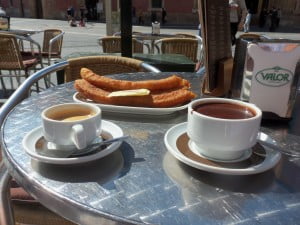
Churros is a kind of large doughnuts served with heavy hot chocolate.
It is delicious!
The casino.
Through the “Calle de la Traperia”, we went to the beautiful Casino .
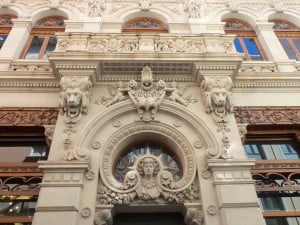
Now, the Casino is a private club and a Murcian institution, we had to pay for the visit but it is worth it.
The style is mixed classical and modernist elements.
The entry hall is Moorish patio , influenced by the Alhambra in Granada.
The Casino who is built-in 1847, houses a beautiful Arabic patio, a library and a Ladies powder room!
But also a splendid Baroque ballroom decorated in the style of Louis XV and private billiards room for the local members of the club.
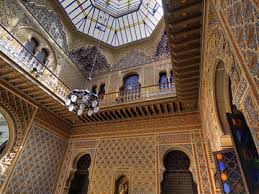
Tips Before visiting Murcia.
We went in the eastern vacation. So the time of the year of the ” Semana Santa “.
Murcian people are very devoted, so you need to know that there is a famous ” Semana Santa, the Easter Week. For the locals it is one of the most important weeks full of devotion.
In fact, in the Easter week there are very special holy processions.
Naturally, most of the shops are closed in this week and we did not knew it.
The locals have days off to celebrated the Holy Week or ” Semana Santa”.
So before visiting, always check if there isn’t a local holiday.After all if everything is closed, you van’t not go shopping or visit some museums.
Museums in Murcia.
In fact, there are several interesting and beautiful museums, like the Science Museum or the Archaeological Museum.
The Sangre Museum houses the procession Holy week sculptures of the 17th to the 20th century. It is owned by the Brotherhood of the Holy Blood. They are known as the Reds due to the color of the tunics they wear on their Holy Week Parade.
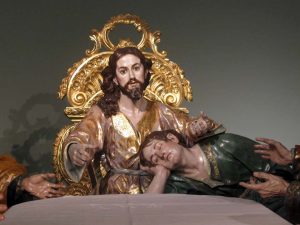
In other words,the visit to the museum is also the moment to admire a large collection of items used in the Holy week. Like there are embroidery, gold, banners, silver and musical instruments.
One of the most important processional images in wood can be found in the Salzillo Museum.
Equal, paintings by Spanish artist from the 16th to the 20th century can be discovered in the Fine arts Museum.
Next, in the Archaeological Museum there is a large collection of Roman, Greek and Moorish artifacts.
Visitor center.
Furthermore, the “Muralla the Murcia” is a visitor center. The center accommodates a section of the medieval city wall that once surrounded the town. It houses also one of the gates used for centuries to enter the old city.
indeed, the museum learn the visitor about the most important historical events of Murcia. From the first wall after the foundation in the 9th century and the transformations throughout the history.
Close to the Junterones Palace is located the City Museum. In the museum there are interactive displays. On the displays, you can learn more about the several civilizations that have crossed Murcia the last 2000 years.
Finally, in the San Juan de Dios Church and in its museum you can see various religious woodcarvings.
The Rio Segura.
The Rio Segura is a river through the city center.
A walking path runs either side of the river.The “Paseo Del Malecon” near the river Segura is a nice walk out the city and back.
The old bridges over the river, the Rio Segura are called the ” Puente de Pelligros” or Bridge of the pilgrims and the ” Puente Viejo” or the Old bridge .
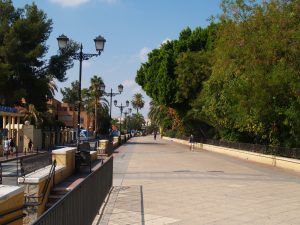
Once crossing one of the bridges you arrive in one of Murcia’s popular neighborhoods.
The neighborhood is called ” El Barrio del Carmen”. It is certainly one of the popular by the locals. The barrio is located on the right bank of the River Segura. It was formed outside the medieval walls of the old city. The first thing to discover is one of the most characteristic spaces of the “Barrio” the ” Plaza de Camachos”.
For the lovers of walking, there are self guided walks for the city described in the Murcia Square booklet. This booklet is available from the Tourist information Office. The leaflet is available in the different languages.
Furthermore.
The River Mills museum is located in a late 18th century complex of historical interest.
The River Mills is a clear example of the important of the river and the strength of the water.
Those places were important for food and work, were milling grain was an essential part of life.
The building preserves the apparatus from the day it was active.
It had been restored in the late 1980.
In the library there are exhibitions on the local folklore, the ethnographic and the hydraulic engineering.
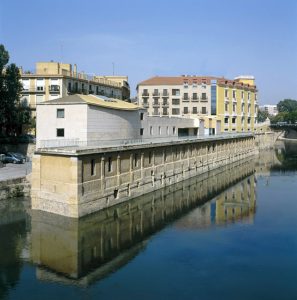
Nearby the university is the Museum of the University, with temporary exhibitions on different themes like arts and science. The museum is inaugurated in 2003 in the former Artillery Barracks.
Aquarium.
A nice visit for families with children is the Aquarium.
The aquarium of the University of Murcia has tanks with fish and corals of the Pacific Ocean, the Indian Ocean, the Caribbean Ocean and the Indian Ocean.
And of course learn more about the Mediterranean sea and more especially the Mar Menor. See the page on our website about Mar Menor.
For children the Science and Water museum is worth a visit.
Water is the main theme of the Museum, but the building got also a planetarium and a Discovery room.
There is a variety of workshops, exhibitions and courses on a different themes related with water
It has been opened in 1998 on the same place were the old water deposits used to supply Murcia.
For the lovers of ” Carmen” of Bizet, toreadors and picadors : in the bullfighting Museum of Murcia. They see a lot of colorfully posters, costumes of famous bullfighters and materials .
The Museum has a specific library and video collection.
Ramon Gaya got his own museum in Murcia. He is one the best contemporary local artists.
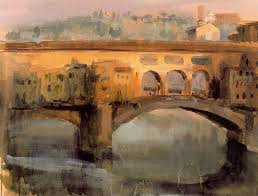
Local craft work is for sale in the Regional Craft Center.
Tip.
The most museums are closed for the siesta which is in the summer from 2 till 5 in the afternoon and in the winter from 2 till 4 .
Shopping in Murcia city center.
The commercial streets are Traperia, Plateria and the avenue Alfonzo X.
There are many local shops but also many well-known shops like the Zara , The Cortes Ingles or Mango.
We even dedicated a page for all the Shopping Centres . or you can even a do a small trip to the Orihuela Costa and La Zenia Boulevard
Eating in Murcia.
In the first place, the city is also famous for its excellent tapas. Murcia serves some of the best food in Spain.
One example , is the real temptation to spend the whole day between the many tapas bars.
We went to the charming “Plaza des Flores”. In the evening , there are a large number of bars and taverns with great choice of delicious tapas.
For instance , the Plaza des Flores is surrounded by palms and orange trees. In the morning there is a nice flower market.
On the one hand Murcia’s specialty are rice dishes ” Arroz Calder . But don’t forget to taste also , the “Zarangollo” , bean omelet, the “ michirones ” again beans with ham bone. On the other hand the sausage , bacon, bay leaf and pepper, rabbit stew, potatoes with garlic…..
Additionally, the Plaza des Flores is plenty with locals, and there is a great relaxed atmosphere . Indeed, it is the perfect place to sit, relax and enjoy.
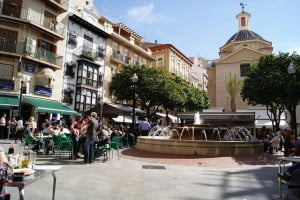
Fruit Market in Murcia.
Indeed, Murcia is well-known for the fruit and market gardens.
You can go to the famous Veronica market with fresh products straight from the garden.
While , you can taste the fresh “ dates ” on the market. Never tasted dates that were so good.
At the 1st level they sell fish and seafood directly from nearby the Mar Menor.
As you can see, we will surely come back to Murcia, this beautiful authentic lovely Spanish town.
